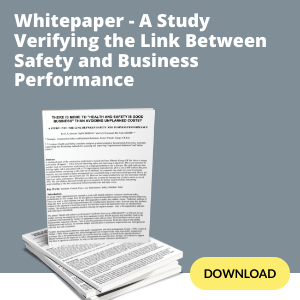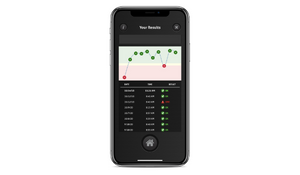What Does Fit for Work Mean?
According to CCOHS, "'fit for work' or 'fitness to work' is typically a medical assessment done when an employer wishes to be sure an employee can safely do a specific job or task."
A medical fit for work assessment often involves a physiological exam to ensure that a worker is able to perform certain physical tasks such as lifting heavy objects, "crouching and bending for prolonged periods of time, and maneuvering into small spaces" (Concentra).
Types of Fit For Work Assessments
However, a fit for work assessment can take other forms besides just a medical physical assessment. For example, many employers also utilize the following to determine if a worker is fit for work on an ongoing basis, both physically and mentally:
- drug tests
- impairment tests
- wearable devices
Workplace Accidents and Choosing a Fit for Work Assessment
To determine which fit for work test will be most effective for your industry and your workers, it's important to analyze leading and lagging indicators of safety risk at your company. Past safety violations and incidents are a type of lagging indicator that can be used to identify harmful trends and propose new safety policies and procedures.
When you look at your past safety violations and accidents, you should consider to what degree these accidents were preventable.
Did any fit for work assessment help you predict that this would happen?
If not, could a different fit for work assessment help you predict it in the future?
For example, drug testing is the most common fit for work assessment since it is required by law and is a part of corporate policy in safety-sensitive industries. Although drug use must be strongly deterred, especially within safety-sensitive workplaces, many workplaces have identified several shortcomings that make drug testing inadequate as a fit for work assessment.
Read about these 7 drug testing shortcomings here.
To aid you in your analysis of your past accidents, we will look at the top 5 most common causes of workplace accidents and determine what type of fit for work assessment, if any, could have prevented them.
The Top 5 Most Common Causes of Workplace Accidents and Their Fit For Work Relationship
Evaluating Fit for Work - Overexertion
"Overexertion causes 35% of all work-related injuries and is, by far, the largest contributor to workers’ compensation costs" (Green Guard).
This is the most common cause of injury to employees.
According to Green Guard, "overexertion causes 35% of all work-related injuries and is, by far, the largest contributor to workers’ compensation costs – more than $15 billion, or 25% of the total cost in 2012...It also is the #1 reason for lost workdays. More than 322,00 people missed work that year due to overexertion."
Whether attempting to lift something that is too heavy or regularly overexerting themselves over a long period of time, overexertion is obviously very detrimental to workers and their companies.
On the surface, overexertion can be seen as a result of worker misjudgment or overconfidence.
If you look more deeply, you might conclude that it's due to poor or inadequate training or a lack of supervisory presence.
You might further conclude that your workplace safety culture does not encourage accountability and personal responsibility for safety.
If you're an especially constructive and critical thinker, you might consider the role that mental and physical fatigue have played. A worker who hasn't taken a break when they should have, suffering from dehydration, operating on little sleep, or burdened by a personal problem, could very easily misjudge their ability to work safely, forget about any previous training, and overlook their personal responsibility to be safe.
If your workplace has reached this level of analysis, a fit for work test that can identify mental and physical fatigue will be your best tool to help prevent future overexertion accidents.
Evaluating Fit for Work - Slips and Falls
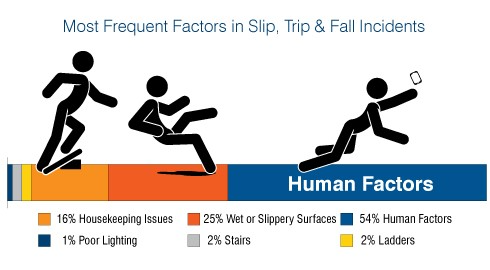
(Photo credit: Southern Utah University)
Falls are the second most common and costly forms of workplace accidents.
Falling accidents are sometimes separated into same-level falls--such as falling to the ground while walking or working, or falling into or against objects on the same level as the worker--and different-level falls, such as falling off a ledge, ladder, or other elevated working surfaces.
According to the Liberty Mutual Workplace Safety Index, falls on the same level was the second-leading cause of workplace injury claims, totaling 19.2% of all claims. The third-highest cause of workplace compensation claims fell to a lower level, totaling 10% of all claims. (Cogburn Law)
In your analysis of falling accidents, you will no doubt examine whether the working area was slippery, whether ladders were used properly, and whether PPE such as harnesses were worn. Knowing that the majority of falling accidents are due to human factors, you might look further. (Southern Utah University)
You might do a post-accident drug test, revisit worker training, and ask the supervisor on duty where he was.
If you're unsatisfied, you might examine other personal factors such as fatigue and impairment.
After all, fatigue and impairment clearly affect motor skills and balance. Compromised focus and unsteady hands and feet are the perfect recipe for trips and slips, or falls from heights.
If you suspect impairment beyond what a drug test could proactively indicate, a fit for work tool that indicates impairment in real-time is what you need.
Evaluating Fit for Work - Being struck by an object
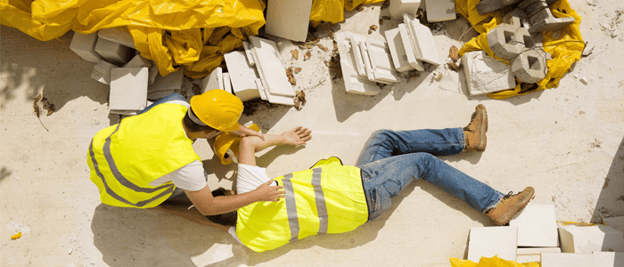
(Photo credit: Construct Connect)
Being struck by an object or equipment made up 9.1% of workplace injury claims in 2018 (Cogburn Law).
The first questions that you might ask after an accident of this type revolve around whether PPE was worn, whether all equipment was in good working condition, whether proper housekeeping was done.
You might do a post-accident drug test to see if the worker who was struck was at fault.
You examine the role of other workers on the scene, and those responsible for the equipment or object involved in the accident.
When these fail to get to the heart of the matter, you wonder if anyone on the scene was distracted and not paying attention to the possible hazards around them.
If this is what you're asking now, you would benefit from a fit for work assessment that has the capability to reveal stress and preoccupation. Personal problems and stress can culminate in a disastrous moment of distraction, as seen in these stories from the field.
Evaluating Fit for Work - Roadway accidents
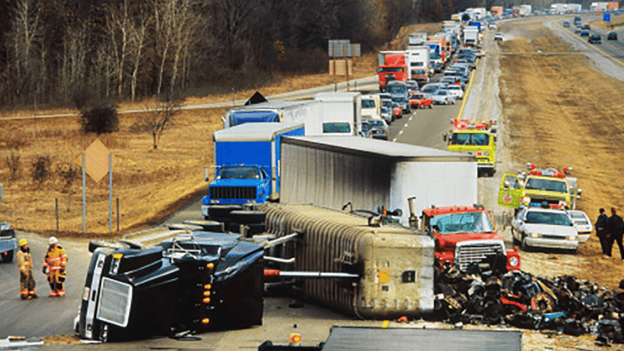
(Photo credit: EHS Today)
To prevent roadway accidents, a fit for work assessment that is comprehensive enough to identify many different forms of impairment is essential.
Many occupations require traveling by motor vehicle. According to Cogburn Law, road accidents made up 5.5% of total injury costs to U.S. employers in 2018. (Cogburn Law)
After speeding and distraction, impairment was identified as the third leading cause of driver-related fatal large truck accidents, according to the FMCSA 2018 large truck crash reports.
Amongst the top impairments identified in the 2018 report were:
- substance abuse
- followed by fatigue
- illness
- and emotional distress.
Among worst-case scenarios, a seriously fatigued driver, for example, could fall asleep behind the wheel. It is also well known that cognitive impairment increases the prevalence and likelihood of errors, and errors made while behind the wheel can be costly. Plus, although a tired employee driver may not himself make an error, his impaired state may affect his ability to react in time to other drivers’ errors.
Given the variety of possible impairments that could easily culminate in a disastrous road accident, a fit for work assessment that is comprehensive enough to identify many different forms of impairment is essential.
Evaluating Fit for Work - Being Compressed by an Object or Equipment

Accidents involving compression by equipment or objects were the 4th most common workplace accidents, making up 3.6% of all workplace injuries in 2018. (Cogburn Law)
Similar to being struck by an object, there may be a multitude of contributing factors at play behind these type of accidents.
However, you might not be able to get to the root of the problem without a fit for work assessment that identifies all forms of mental impairment, such as those that lead to a lapse in judgment or an error while operating, cleaning, or repairing heavy equipment.
Evaluating Fit for Work - Repetitive Motions
The final most common workplace accident is repetitive motions.
These accidents made up 2.6% of total injury costs to employers in 2018. (Cogburn Law)
Similar to overexertion, repetitive motions lead to physical fatigue which wears down the body and leads to injury. In addition, repetitive motions are often tedious as well, leading to mental fatigue and the associated cognitive impairment. An employee in such a state presents not only a high risk for suffering an injury but also heightens the safety risk of those around him.
When analyzing the cause of repetitive motion injuries, your workplace safety procedures, compliance with break times, and proper use of equipment are often the first areas to look at.
To make such analyses easier, the fit for work assessment you use should be able to identify when a repetitive motion is becoming tedious to the level of causing boredom and distraction. These can culminate in mental fatigue and cognitive impairment, leading to more accidents.
Conclusion
Although these 5 common workplace accidents might be expected when working with fallible humans in a dangerous work environment, most don't realize the degree to which they are preventable.
Fit for work assessments are continually improving and becoming more insightful, thanks to modern technology.
Workplaces no longer need to rely solely on drug tests and constant supervision.
Cameras, wearables, and real-time safety metrics make proactive safety a lot less time-consuming.
Further, fit for work tests are now equipped to look at more than physical ability. They also measure commonly disastrous factors such as cognitive impairment and fatigue.
Best of all, they don't take as long as a drug test or a medical evaluation by a doctor.
For example, the AlertMeter®, an app available on smartphones and tablets, takes only 1 minute to identify impairment due to fatigue, illness, preoccupation or distress, intoxication, dehydration, and more.
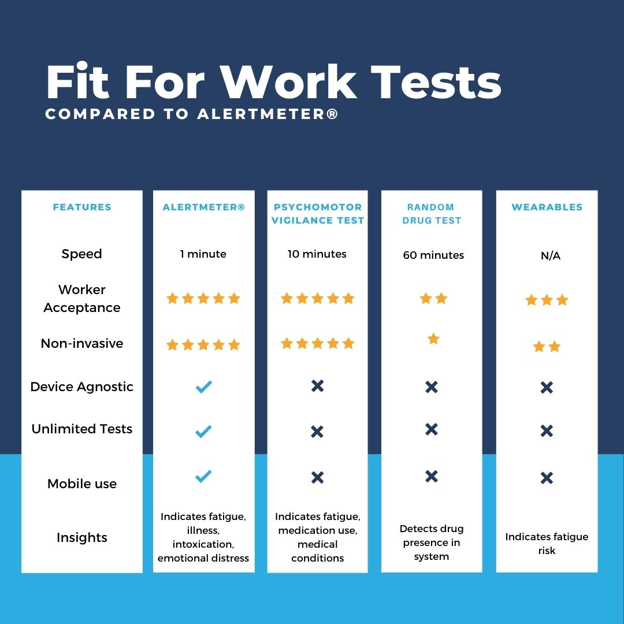
Whether made apparent or not, some sort of cognitive impairment is often at the root of workplace accidents. Being willing to look deeper and see more will become a larger part of what it means to be a safety-conscientious company as the technological tools to do so become more widely available.





